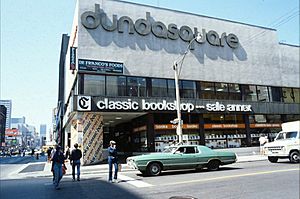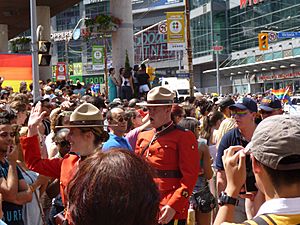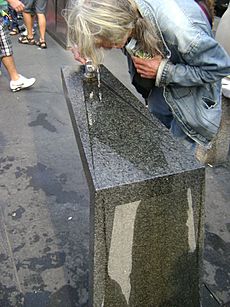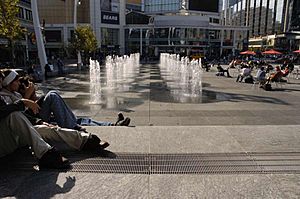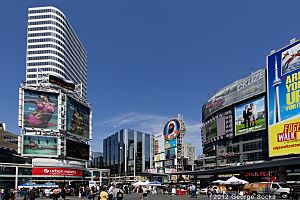Yonge–Dundas Square facts for kids
Quick facts for kids Yonge–Dundas Square |
|
|---|---|
| Public square | |
| YD Square, Dundas Square, Yonge–Dundas | |
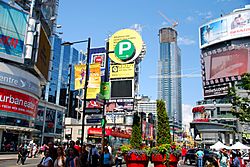 Yonge–Dundas Square in 2013 |
|
| Features: | concert stage; splash water features |
| Design: | Brown and Storey Architects |
| Construction: | 1998–2002 |
| Opening date: | 2002 |
| Amenities: | live theatre box office, washrooms, underground parking, subway |
| Area: | 1 acre (0.40 ha) |
| Surface: | Granite |
| Owner: | City of Toronto |
| Manager: | Yonge–Dundas Square Board of Management |
| Location: | 1 Dundas Street East Toronto, Ontario M5B 2R8 |
|
Location of Yonge–Dundas Square in Toronto |
|
Yonge–Dundas Square, also known as Dundas Square, is a lively public space in Downtown Toronto, Ontario, Canada. It sits at the southeast corner where Yonge Street and Dundas Street East meet.
This square was designed by Brown and Storey Architects. It was created in 1997 to help make the area more exciting. Since it opened in 2002, the square has become a very important landmark in Toronto. It hosts many public events, shows, and art displays. It's also a popular spot for tourists.
Yonge–Dundas Square is right in the middle of the Downtown Yonge shopping and entertainment area. The city owns it, and it's special because it's the first public square in Canada managed by a mix of public and private groups. The intersection nearby is one of the busiest in Canada. Over 100,000 people cross it every day using the city's first pedestrian scramble.
Around the square, you'll find other famous places. These include the Toronto Eaton Centre, the Ed Mirvish Theatre, and the Citytv building. You can easily get to the square by subway at Dundas station. It's also connected to the PATH underground walkway system. The square is always bright with huge billboard screens and company logos. This makes it look a lot like Times Square in New York City or Piccadilly Circus in London.
Contents
History of Yonge–Dundas Square
In 1998, the Toronto City Council decided to create Yonge–Dundas Square. This was part of a bigger plan to improve Yonge Street. They bought the buildings on the site and had them taken down.
The square was a team effort. The city worked with local residents, business groups, and associations. Important people like Councillor Kyle Rae helped lead this project. The square was designed by Brown + Storey Architects. The idea was to create a new public space, similar to Nathan Phillips Square at New City Hall.
In 1999, the square's design won an Award of Excellence from Canadian Architect magazine. This award recognized it as an amazing example of modern design. The next year, Architecture magazine praised the square as a new and exciting urban space.
Unlike Nathan Phillips Square, Yonge–Dundas Square is managed by a special group called a Board of Management. The city owns the land, but this board runs the square. This board was set up in 2001. It was the first time in Canada that a public square was run by a partnership between public and private groups. In 2006, the square's Wi-Fi hotspot was named the best in the city.
Many people say this intersection is the busiest in Canada. Over 56 million people pass through it each year. The square's design was inspired by famous places like New York's Times Square and London's Piccadilly Circus. To help people cross safely, a special pedestrian scramble was added in August 2008. This means all traffic stops, and people can cross in any direction.
The square is often used for public events and city festivals. These include NXNE, the Toronto International Film Festival, Luminato, Nuit blanche, and Pride Week. For example, on June 29, 2014, the square hosted the official closing events for WorldPride.
Yonge–Dundas Square belongs to the City of Toronto. Rules for using the square are found in Toronto Municipal Code Chapter 636. These rules cover what activities are allowed. Since April 2014, smoking is not allowed anywhere on the square.
Design of the Square
The square is surrounded by streets. Dundas Street is to the north, Victoria Street to the east, and Yonge Street to the west. A smaller street called Dundas Square forms the southern edge. The main Dundas Street used to be made of different streets connected together.
The square is built on a slight slope. The architects, Brown and Storey, said this was done to make it feel like a stage. The surface is made of large, textured granite slabs. The square also has a zinc canopy that runs diagonally along one side. There's a movable stage for concerts and shows. Bright fountains are set right into the ground. Small trees line the southern edge, and there's a clear canopy over the stage. A new entrance to Dundas subway station is also part of the design. In 2005, some round stone planters were added to the west side.
Because Dundas Street curves at the square, it's not a perfect square. It's actually an irregular five-sided shape. The angled side has a structure supported by 11 concrete pillars. This gives it an industrial look. This structure is on the north side, so it doesn't cast shadows on the rest of the square. The other three sides are straight, forming right angles with Yonge and Dundas Streets. There's also a small road called Dundas Square that crosses the area, connecting Yonge Street to Dundas Street.
Square Features
The surface of Yonge–Dundas Square slopes upwards away from Yonge Street. This slope helps create enough space for the entrance to the Toronto Parking Authority garage underneath. The architects designed the slope to make the space interesting and to fit everything built below it. On the first underground level (P1), you'll find washrooms, changing rooms, a green room for performers, and rooms for utilities and the fountain's water treatment system.
At the southeast and southwest corners of Yonge–Dundas Square, there are public drinking fountains. The one on the southwest corner (closer to Yonge Street) is known for its strong, cool stream of water. The other fountain has a warmer, less powerful stream. The fountain near Yonge Street is also close to a raised area that people often use as a seat.
Fountains
The main attraction of the square is its amazing fountains, designed by Dan Euser. Two rows of ten fountains are spread out across the main walking area. This allows visitors to walk right through or around the water. Unlike many city fountains, the Dundas Square fountains are made for playing in. They have a special filter system that keeps the water very clean, like swimming pool water. The water is treated to be safe for people to play in. The dark granite used for the square's surface is not slippery, which helps keep people safe when they are playing in the fountains. Each of the 10 fountains has a metal grate with 30 nozzles underneath.
The dark granite surface of the square absorbs sunlight, making it warm to sit on. The water for the fountains flows under these warm slabs, so the water is heated by the sun. Along the south side of the square, there are three curved lighting poles. These poles are white and shiny, contrasting with the rough black granite. They hold lights that make the square bright in the evening, like natural sunlight.
The fountains are like a moving art display. The 600 water jets are programmed to change how they spray over time. The fountains usually run 24 hours a day. Dundas Square is one of the few places in Toronto where you can play in the water all day and night. The fountains typically operate from mid-April until the end of October.
To save money, only the middle nozzles of each fountain can be animated. The outer nozzles can be controlled together. The outer nozzles often create a steady background spray while the middle ones put on a show for about eight seconds. The way the middle nozzles spray encourages people to run west through the water.
The architects, fountain designer, and square management all agree that playing in the water was a key idea for the space. The fountains are meant to be fun for both children and adults, and they have proven to be very popular.
Many people drink from the fountain sprays or even fill water bottles. Because of this, and since waterplay is encouraged, the water is tested daily by the Toronto health department. The water is treated with bromine, which many people prefer over chlorine. There are three separate water treatment systems for the fountains. The water flows under the square's raised floor to the treatment facility.
Buildings Around the Square
Yonge–Dundas Square is part of the Downtown Yonge business area. Other big projects in the area include changes to the Toronto Eaton Centre. A new shopping and cinema complex called 10 Dundas East opened to the north in 2007. Also, 33 Dundas Street East opened to the southeast. On October 22, 2007, Rogers Media announced they would buy this building for their Citytv and Omni Television stations, and it is now in use.
A "media tower" has been built on the northwest corner of Yonge and Dundas. This tower holds many large billboards and is said to be the tallest media tower in the world. Another big media tower with a video screen is a main feature of the Rogers Media building on the southeast corner. This screen usually shows the CITY-TV broadcast. The building on the southwest corner, which used to be the Hard Rock Cafe, also had billboards. These were replaced by a large video screen in 2017. The addition of these huge screens and bright advertisements has changed the look of the area.
The changes to the Eaton Centre and the building at Victoria and Dundas were finished in 2004. The 10 Dundas East project started in 1999 and opened in stages starting in 2007. In 2019, a huge curved video screen was added to the corner of the building facing Yonge and Dundas.
See also
 In Spanish: Yonge-Dundas Square para niños
In Spanish: Yonge-Dundas Square para niños


